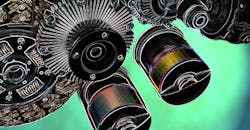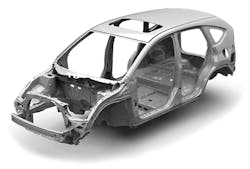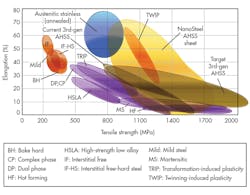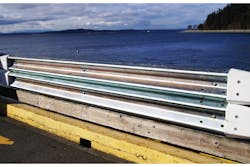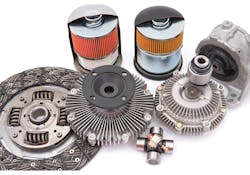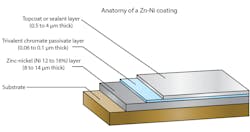Download this article in PDF format.
Thousands of years before current era (BCE), people were using copper. Tin was added a few hundred years later, thus sparking the Bronze Age. This first work in metallurgy would set the pace for inventions, world economies, and wars won through the knowledge of controlling these elements. Today, knowledge is still the key.
This article will cover some of the successes and challenges in bringing these revolutionary materials to market. First, what are nano-metals? They are defined as metals controlled or altered on a nanometer scale. Sometimes it represents a buzzword for a new alloy or composite that may or may not actually be altered at the nano-level.
Nano-Metals in Automotive
With the push for more fuel-efficient and safer vehicles, high-strength steels are showing up in more white bodies of vehicles today. While aluminum might sound like a natural switch, the amount of material needed to match the strength of steel would require new molds as well as adjustments to the equipment for the change in volume.
Many studies in lightweighting vehicles focus on the body in white. It consists of the vehicle’s non-moving parts, and is usually made of sheet-metal components. “Many of the metals in cars today did not exist 15 to 20 years ago,” says Dave Paratore, President and CEO for NanoSteel (Courtesy of Honda).
Ford invested heavily in this, but not all car manufacturers have the ability to make the necessary upgrades. Other automotive manufacturers are looking for advanced high-strength steels that will work with current production lines. Many alloys can increase strength, but this would alter the metals’ formability properties, causing them to crack when being stamped into the desired shapes.
This challenge led NanoSteel, based in Providence, R.I., to experiment with novel recipes and thermochemistry to produce, in bulk, a new type of steel that contains nanoscale microstructures. Such a construct can deliver unique combinations of strength and ductility. The company uses conventional steel alloying elements, but in novel ratios. Process control and alloying ratios dictate the resulting properties. The end result is stronger, formable steel that’s designed to be used in today’s automotive plants.
The auto industry is pushing for third-generation, advanced high-strength steels. The materials properties aren’t specifically defined, but the figure shows the target for the tensile strengths and elongation percentages of the current and target third-generation materials.
Nano-metals help reduce the weight of vehicles while increasing strength. This is just one example of how the slightest adjustments in chemistry can affect the final product.
Microalloying
If the ratio is such an important factor, how much of an alloy can change a metal’s property?
Many additives might be as little as 0.5% of a specific alloy, but as little as 0.03% of them have been used to alter properties. This slight addition changes the microstructure of the product. Often, steels will increase in strength, because alloys can slow the recrystallization of austenite that causes the grain size to become finer.
Another example is that small amounts of niobium and vanadium can improve surface hardness, which in turn increases resistance to wear, also known as carbonitriding. Refining the grain size, shape, and dispersion of slight additions of alloy can hone metals to cater to a wide range of material properties, including cold processes.
Along those lines, the article “Microalloying Strengthens Steel” illustrates that point: “With resulfurized 1144 steel, a carbon grade often chosen for its machinability, a light cold drawing increases its yield strength by 15,000 psi, and a heavier drafting boosts it to 25,000 psi. If vanadium is added, yield strength further increases to about 20,000 psi. Adding vanadium and nitrogen typically increases yield strength by about 30,000 psi. This strength increase is retained after cold drawing.”
Furthermore, microalloying can eliminate the need for annealing in some cases. Between increasing strengths, improving machinability, and reducing energy in post-processing, microalloying demonstrates the importance of understanding the slightest adjustments in chemistry.
Process Control and Layers
How does the process affect the material’s properties? Case in point: By controlling the steel manufacturing process, it is possible to surround martensite with ferrite. This allows the metal to be ductile due to the ferrite, but have the dispersed strong (but brittle) martensite to absorb energy effectively, increasing ductility and strength. This has been a success in the automotive industry. A metal with this composition makes for lightweight, but strong, steel for crumple zones (crumple zones are areas of a vehicle designed to absorb energy in a collision).
The balance between ductility and strength is a battle that’s actually been played out since the times of the Samurai. Folding steel in layers let a Samurai’s sword become hard to keep its edge, but ductile enough so it wouldn’t shatter when struck. Taking these alloying concepts, and combining them with layers and new processes, is now revolutionizing multiple industries and markets.
Modumetal worked with the state of Washington to test guardrails made from laminated nanometals. While they showed better performance at a competitive price, the government enforces a standard that prohibits the Department of Transportation from using this material.
Seattle-based Modumetal Inc. is applying the Samurai sword concept and pushing it to the nanometer scale, using a patented, industrial-scale electrochemical process to produce a class of materials called “nano-laminated alloys.” In the process, metal is electrochemically deposited onto a substrate in nano-scale layers that can vary in composition or microstructure, or both. The end result is an entirely new way of enhancing material properties, including dramatically improved strength, toughness, corrosion, thermal, and wear characteristics, to name a few. In addition, Modumetal is able to mass-produce these metals at a competitive price.
Metal Matrix Composites
The design requirement to make products lighter but still maintain their productivity has increased the demand on metal matrix composites (MMCs). These materials are being used in a variety of industries, including automotive and aerospace applications.
Metal matrix composites (MMC) might not necessarily be a nano-metal—in the case of dispersion hardening, it may not even be layered. However, engineering isn’t about buzzwords—it’s about solving problems. Some benefits engineers are finding with MMCs include higher temperature capability, fire resistance, higher transverse stiffness and strength, no moisture absorption, higher electrical and thermal conductivities, and better radiation resistance. Demand for these properties and lightweight parts has driven the market especially for aluminum MMCs—aluminum currently represents the largest segment (about 30%) of the MMC market.
Dispersion hardening is a non-layered example of a MMC. Controlling the MMC manufacturing can lead to nano-sized second-phase dispersion of a material within a matrix. Where alloying is generally considered bonding of two or more metals, dispersion hardening suspends a material like fiber glass in an epoxy, and can improve adhesion resistance, flexural strength, toughness, and hardness. This has proven successful in multiple industries, particularly in materials for jet engines and turbines.
Fighting Corrosion
Microalloying and MMCs can improve mechanical properties, but chemical properties could save trillions of dollars worldwide. “The National Association of Corrosion Engineers did a study and found that 4.1% of the world GDP is lost to corrosion,” says Christina Lomasney, CEO and President of Modumetal.
Electroplating has been around since the 1800s, but has become more sophisticated. In the 1980s, electroplating began to be used to make zinc-nickel (Zn-Ni) coating to protect against corrosion and wear.
This image shows a cross-section (not to scale) of a typical Zn-Ni coating. The three layers of coating consist of a layer of Zn-Ni alloy, covered by a layer of chromate, with a topcoat or sealant on top.
A general mix of 85% zinc and 15% nickel electroplated in layers onto parts has shown to maintain its corrosion resistance even if formed or bent after coating. In addition, Zn-Ni coatings are able to handle thermal stresses. For example, a test was done on zinc versus Zn-Ni costed parts. Results showed that:
- Zinc handled thermal stresses and maintained its corrosion resistance up to 248°F.
- Zn-Ni retained its corrosion properties at temperatures up to 392°F.
The automotive and aerospace industries are talking a lot about nano-metals, but much of that 4.1% lost GDP comes from corroding infrastructure. Electroplating Zn-Ni and nano-metals can increase corrosion resistance, and can help the U.S. get ahead of the rust, but regulations are stopping production.
A Rusty Government
“Galvanizing technology was standardized in 1928 under ASTM A123. Today, if you look at the Department of Transportation specifications, the standard to use galvanized material is still pervasively specified everywhere. So we are using technology that is about 100 years old,” says Lomasney. “I could produce nano-metal guardrails that last 30 times longer than the current galvanized metals, but we would not be able to use them.” Before you get angry at the government, remember the DOT is just enforcing what the experts are saying is the best action.
The government tried in 1993 to implement standards that were performance-based, but they were fundamentally flawed. Instead of detailed specifications, the DOT just ended up with standards that would say something like “use standard A123, then add a corrosion requirement.” This obviously didn’t fix the problem.
Now, fortunately, there is a bi-partisan Corrosion Prevention Caucus in the House of Representatives that published the following:
“According to a 2001 study by the Federal Highway Administration, corrosion costs the U.S. economy $276 billion every year or roughly 3.1% of our national GDP. When updated to 2015, the cost of corrosion is almost $500 billion annually... When properly installed and maintained, corrosion is largely preventable. Corrosion prevention technologies significantly reduce the risk of harmful effects and the overall financial cost to the U.S. Government.”
Recycling Complex Metals
While the caucus fights for new regulations, we must also consider recycling. If standards are based on performance, but say nothing about the material’s end-of-life, could stockpiles of valuable metal be added to landfills? When dealing with plastics, some countries have banned custom polymers due to recycling difficulties.
Fortunately, with metals, we are already separating precious metals in the smelting process. The recycling of electronics shows that it is possible to recycle complex metal alloys. However, galvanized steel is easy to recycle, too. Any added energy to recycle nano-metals should be considered.
However, if guardrails made with a nano-metal can last 30 times longer than traditional galvanized steel, galvanized steel would theoretically have to take 1/30th the energy than recycling a nano-metal. In addition, the cost and energy to decommission and commission miles of new guardrails at potentially a 30:1 ratio already put nano-metals at a clear advantage.
Finally, what does it cost? Lomasney says nano-metals are cost-competitive. When considering the return on investment, you have to consider you’re eliminating a lot of maintenance and construction cost because they can offer better mechanical and chemical properties than traditional galvanized metals.
From the Bronze Age to the Age of the Samurai, to the industrial and silicon revolutions, history has shown us the importance of material science. If we continue to hold back our technology with outdated or poorly written standards, our economy and infrastructure might also become history.
About the Author

Jeff Kerns
Technology Editor, Machine Design
Studying mechanical engineering at Rochester Institute of Technology (RIT), Jeff Kerns worked in the Polymer Research Lab. Using RIT’s co-op program, he worked for two aerospace companies focusing on drafting, quality, and manufacturing for aerospace fasteners and metallurgy. He also studied abroad living in Dubrovnik, Croatia.
After college, he became a commissioning engineer, traveling the world working on precision rotary equipment. Then he attended a few master's courses at the local college and helped an automation company build equipment.
Growing up in Lancaster County, PA he always liked to tinker, build, and invent. He is ecstatic to be at Machine Design Magazine in New York City and looks forward to producing valuable information in the mechanical industry.
